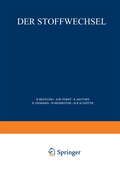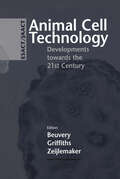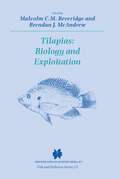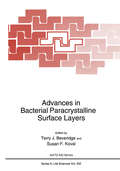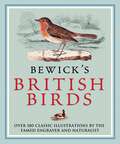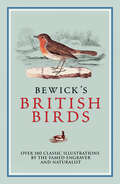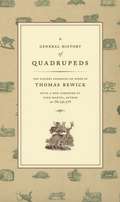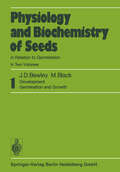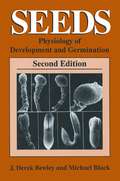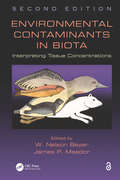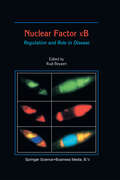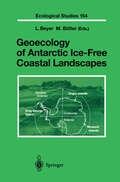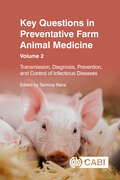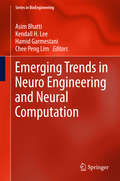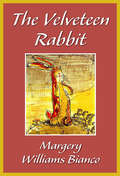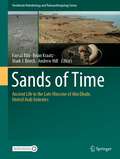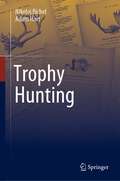- Table View
- List View
Der Stoffwechsel: Zweiter Teil (Physiologische Chemie #2, 2, d/α)
by Ruth Beutler Bonifaz Flaschenträger E. LehnartzAnimal Cell Technology: Developments towards the 21st Century
by E. C. Beuvery W. P. Zeijlemaker J. B. GriffithsAnimal cell technology is a discipline of growing importance, which aims not merely at understanding structure, function and behaviour of differentiated animal cells, but especially at the development of their abilities useful for clinical application. Topics of interest in this regard include: viral vaccines, pharmaceutical proteins and novel applications such as gene therapy and organ culture. Undoubtedly, these Proceedings of the joint Meeting of the European Society for Animal Cell Technology and the Japanese Association for Animal Cell Technology (Veldhoven, The Netherlands, September 1994) review the most recent status of the field, and will be most valuable to anyone actively involved in the culture of animal cells and its applications. The contributions to this volume were strictly selected on the basis of quality and novelty of contents. Kluwer is honoured to be able to add this work to its strongly developing publication programme in cell and tissue culture, which now has its connections to all major Societies in this field worldwide. Audience: Cell biologists, biochemists, molecular biologists, immunologists, virologists and all other disciplines related to animal cell technology, working in an academic environment, as well as in (biotechnology or pharmaceutical) industry.
Tilapias: Biology and Exploitation (Fish & Fisheries Series #25)
by M. C. M. Beveridge B. McAndrewReferred to in the Bible, pictured on the wall-friezes of ancient Egyptian tombs, and a subject of fascination for generations of scientists, the tilapias (Cichlidae: Tilapiini) have featured in the diet and culture of humankind for thousands of years. The present century has seen their spread from Africa throughout the tropics and sub-tropics, largely for food and fisheries purposes. This book attempts to pull together our knowledge of this important group - their biology and fisheries and aquaculture - in a single volume, something that has not been done comprehensively for nearly two decades. A succession of chapters by acknowledged authorities covers evolution, phylogenetic relationships and biogeography, reproductive biology, mating systems and parental care, diet, feeding and digestive physiology, environmental physiology and energetics, the role of tilapias in ecosystems, population dynamics and management, genetics, seed production, nutrition, farming, economics and marketing. The book is aimed at biologists, fisheries scientists, aquaculturists, and all interested in aquatic ecology.
Advances in Bacterial Paracrystalline Surface Layers (Nato Science Series A: #252)
by Terry J. Beveridge Susan F. KovalThis book is a compilation of the research which was presented during the NATO-Advanced Research Workshop (ARW) entitled "Advances in Bacterial Paracrystalline Surface Layers" held in London, Ontario, Canada during September 27 to 30, 1992. The organizing committee consisted of the two Workshop directors, S. F. Kaval and T. J. Beveridge, and H. König, U. B. Sleytr and T. J. Trust; their summary statements about the significance and success of the NATO-ARWare in Chapter 37 of this book. This was the third international workshop on bacterial S-layers and it demonstrated unequivocally how rapidly research is progressing. The Workshop was made possible by financial support from the North Atlantic Treaty Organization (NATO), the Medical Research Council of Canada (MRC), the Natural Seiences and Engineering Research Council of Canada (NSERC), and the Canadian Bacterial Diseases Network (CBDN) which is a Canadian National Centre of Excellence (NCE). We are very grateful for the support from all of these agencies since their financial aid made it possible to bring to London, Canada a truly international group of S-layer experts. We encouraged the attendance and participation of graduate fellows and research associates, and their presentations students, postdoctoral was an intense three constitute the "Poster" section of this book. The NATO-ARW day workshop held at a delightful secluded location (Spencer Hall) so that the delegates had both formal and informal occasions to interact and evolve new ideas.
Bewick’s British Birds
by Thomas BewickWith Bewick on my knee, I was then happy...' Jane EyreCharlotte Bronte's heroine was not alone in her enjoyment of Thomas Bewick's British Birds - since its first publication in 1797 it has become one of the best-loved classics of natural history. Bewick's masterful woodcuts are more than scientific records; each beady eye and jaunty pose betrays the artist's love of birds.This edition includes over 180 bird species, from garden favourites such as robins, blackbirds and finches, to predators such as the osprey and the majestic golden eagle. Each entry is illustrated with an engraving, and throughout the book are narrative vignettes typical of Bewick's playful, engaging style.
Bewick's British Birds: Over 180 Classic Illustrations by the Famed Engraver and Naturalist
by Thomas BewickWith Bewick on my knee, I was then happy...' Jane EyreCharlotte Bronte's heroine was not alone in her enjoyment of Thomas Bewick's British Birds - since its first publication in 1797 it has become one of the best-loved classics of natural history. Bewick's masterful woodcuts are more than scientific records; each beady eye and jaunty pose betrays the artist's love of birds.This edition includes over 180 bird species, from garden favourites such as robins, blackbirds and finches, to predators such as the osprey and the majestic golden eagle. Each entry is illustrated with an engraving, and throughout the book are narrative vignettes typical of Bewick's playful, engaging style.
A General History of Quadrupeds: The Figures Engraved on Wood
by Thomas BewickIn the late eighteenth century, the British took greater interest than ever before in observing and recording all aspects of the natural world. Travelers and colonists returning from far-flung lands provided dazzling accounts of such exotic creatures as elephants, baboons, and kangaroos. The engraver Thomas Bewick (1753–1828) harnessed this newfound interest by assembling the most comprehensive illustrated guide to nature of his day. A General History of Quadrupeds, first published in 1790, showcases Bewick’s groundbreaking engraving techniques that allowed text and images to be published on the same page. From anteaters to zebras, armadillos to wolverines, this delightful volume features engravings of over four hundred animals alongside descriptions of their characteristics as scientifically understood at the time. Quadrupeds reaffirms Bewick’s place in history as an incomparable illustrator, one whose influence on natural history and book printing still endures today.
A General History of Quadrupeds: The Figures Engraved on Wood
by Thomas BewickIn the late eighteenth century, the British took greater interest than ever before in observing and recording all aspects of the natural world. Travelers and colonists returning from far-flung lands provided dazzling accounts of such exotic creatures as elephants, baboons, and kangaroos. The engraver Thomas Bewick (1753–1828) harnessed this newfound interest by assembling the most comprehensive illustrated guide to nature of his day. A General History of Quadrupeds, first published in 1790, showcases Bewick’s groundbreaking engraving techniques that allowed text and images to be published on the same page. From anteaters to zebras, armadillos to wolverines, this delightful volume features engravings of over four hundred animals alongside descriptions of their characteristics as scientifically understood at the time. Quadrupeds reaffirms Bewick’s place in history as an incomparable illustrator, one whose influence on natural history and book printing still endures today.
A General History of Quadrupeds: The Figures Engraved on Wood
by Thomas BewickIn the late eighteenth century, the British took greater interest than ever before in observing and recording all aspects of the natural world. Travelers and colonists returning from far-flung lands provided dazzling accounts of such exotic creatures as elephants, baboons, and kangaroos. The engraver Thomas Bewick (1753–1828) harnessed this newfound interest by assembling the most comprehensive illustrated guide to nature of his day. A General History of Quadrupeds, first published in 1790, showcases Bewick’s groundbreaking engraving techniques that allowed text and images to be published on the same page. From anteaters to zebras, armadillos to wolverines, this delightful volume features engravings of over four hundred animals alongside descriptions of their characteristics as scientifically understood at the time. Quadrupeds reaffirms Bewick’s place in history as an incomparable illustrator, one whose influence on natural history and book printing still endures today.
A General History of Quadrupeds: The Figures Engraved on Wood
by Thomas BewickIn the late eighteenth century, the British took greater interest than ever before in observing and recording all aspects of the natural world. Travelers and colonists returning from far-flung lands provided dazzling accounts of such exotic creatures as elephants, baboons, and kangaroos. The engraver Thomas Bewick (1753–1828) harnessed this newfound interest by assembling the most comprehensive illustrated guide to nature of his day. A General History of Quadrupeds, first published in 1790, showcases Bewick’s groundbreaking engraving techniques that allowed text and images to be published on the same page. From anteaters to zebras, armadillos to wolverines, this delightful volume features engravings of over four hundred animals alongside descriptions of their characteristics as scientifically understood at the time. Quadrupeds reaffirms Bewick’s place in history as an incomparable illustrator, one whose influence on natural history and book printing still endures today.
A General History of Quadrupeds: The Figures Engraved on Wood
by Thomas BewickIn the late eighteenth century, the British took greater interest than ever before in observing and recording all aspects of the natural world. Travelers and colonists returning from far-flung lands provided dazzling accounts of such exotic creatures as elephants, baboons, and kangaroos. The engraver Thomas Bewick (1753–1828) harnessed this newfound interest by assembling the most comprehensive illustrated guide to nature of his day. A General History of Quadrupeds, first published in 1790, showcases Bewick’s groundbreaking engraving techniques that allowed text and images to be published on the same page. From anteaters to zebras, armadillos to wolverines, this delightful volume features engravings of over four hundred animals alongside descriptions of their characteristics as scientifically understood at the time. Quadrupeds reaffirms Bewick’s place in history as an incomparable illustrator, one whose influence on natural history and book printing still endures today.
A General History of Quadrupeds: The Figures Engraved on Wood
by Thomas BewickIn the late eighteenth century, the British took greater interest than ever before in observing and recording all aspects of the natural world. Travelers and colonists returning from far-flung lands provided dazzling accounts of such exotic creatures as elephants, baboons, and kangaroos. The engraver Thomas Bewick (1753–1828) harnessed this newfound interest by assembling the most comprehensive illustrated guide to nature of his day. A General History of Quadrupeds, first published in 1790, showcases Bewick’s groundbreaking engraving techniques that allowed text and images to be published on the same page. From anteaters to zebras, armadillos to wolverines, this delightful volume features engravings of over four hundred animals alongside descriptions of their characteristics as scientifically understood at the time. Quadrupeds reaffirms Bewick’s place in history as an incomparable illustrator, one whose influence on natural history and book printing still endures today.
Physiology and Biochemistry of Seeds in Relation to Germination: 1 Development, Germination, and Growth
by J. D. Bewley Michael BlackSeeds: Physiology of Development and Germination
by J. Derek Bewley Michael BlackIn response to enormous recent advances, particularly in molecular biology, the authors have revised their warmly received work. This new edition includes updates on seed development, gene expression, dormancy, and other subjects. It will serve as the field's standard textbook and reference source for many years to come.
Environmental Contaminants in Biota: Interpreting Tissue Concentrations, Second Edition
by W. Nelson BeyDiscussing the interpretation of tissue concentrations of contaminants in wildlife, this updated edition of a bestseller draws on current scientific research and includes new chapters and greater emphasis on aquatic organisms. Each chapter provides a summary and review of a specific chemical along with direction on research methods and the interpretation of conflicting or insufficient data. Chapters include a comprehensive history of contaminant interpretation in wildlife and fish, the use of tissue residues in ecological risk assessment, and detailed coverage of all bioaccumulative contaminants and their physiologic affects.
Nuclear Factor кB: Regulation and Role in Disease
by R. BeyaertSeventeen years after its initial description, nuclear factor-KB (NF-KB) endures as one of the most studied transcription factors. NF-KB has attracted widespread interest based on the variety of stimuli that activate it, the diverse genes and bio logical responses that it controls, the striking evolutionary conservation of struc ture and function among species, and its involvement in a variety of human diseases. The biochemical basis by which several stimuli converge to activate NF-KB has been largely elucidated during recent years. While first discovered as a key regulatory factor of the immune system, NF-KB is now recognized as an important player in the functioning of many organs and cell types. The ongoing examination of NF-KB signaling has revealed its ever expanding role in immune and inflammatory responses, but also in cancer and development. For this reason, numerous efforts are underway to develop safe inhibitors of NF-KB to be used in the treatment of both chronic and acute disease situations. The present book is the first to review and synthesize our knowledge of this interesting transcription factor. As such, the choice of subjects to review was daunting. To set the stage, an introductory chapter on activators and target genes, as well as the role they play in several responses, has been included.
I Don’t Really Love You: And Other Gentle Reminders Of Existential Dread In Your Everyday Life
by Alex BeyerGo from aww to awful! with I Don't Really Love You, a darkly humorous collection of adorable pet photography and soul-crushing one-liners, based on the popular Instagram @365DaysofDread. Drawing on the black humor of author Alex Beyer, I Don't Really Love You takes readers on a journey from delightful to depressing (and back again!). Dead pan captions, from "Birthdays don't matter" to "Inadequacy haunts me endlessly," peek out from behind the forms of calm cats and happy-go-lucky puppies, creating an unexpected contrast and offbeat appeal. Pet lovers and humor lovers will be captivated in equal measure, with more than 75 full-color photographs of cats and dogs in a range of breeds, alongside an off-beat, subversive voice. With the perfect attitude for our rapidly changing world, this quirky book will make readers laugh out loud (after sending them crawling under the covers to contemplate their existence).
Geoecology of Antarctic Ice-Free Coastal Landscapes (Ecological Studies #154)
by L Beyer M. BölterResearch in Antarctica in the past two decades has fundamentally changed our perceptions of the southern continent. This volume describes typical terrestrial environments of the maritime and continental Antarctic. Life and chemical processes are restricted to small ranges of ambient temperature, availability of water and nutrients. This is reflected not only in life processes, but also in those of weathering and pedogenesis. The volume focuses on interactions between plants, animals and soils. It includes aspects of climate change, soil development and biology, as well as above- and below-ground results of interdisciplinary research projects combining data from botany, zoology, microbiology, pedology, and soil ecology.
Environmental Contaminants in Biota: Interpreting Tissue Concentrations, Second Edition
by W. Nelson Beyer James P. MeadorExamining tissue residues of contaminants in biota reveals the movement of contaminants within organisms and through food chains as well as the context for understanding and quantifying injuries to organisms and their communities. Yet tissue concentrations of some contaminants are especially challenging to interpret and the ability of today's analy
Current Topics in Insect Endocrinology and Nutrition: A Tribute to Gottfried S. Fraenkel (pdf)
by Govindan BhaskaranKey Questions in Preventative Farm Animal Medicine, Volume 2: Transmission, Diagnosis, Prevention, and Control of Infectious Diseases (Key Questions)
by Sonam Bhatt Snehil Gupta Surbhi Gupta Sushma Gupta K. Jayalakshmi K. Karthika Anil Kumar Simant Kumar Nanda Arpita Padhy Abhishek Pathak Jigar Raval Amit Ranjan Sahu Rajesh Kumar Sahu Barkha Sharma Jitendra TiwariProviding well over 1,000 questions to test your knowledge of preventative farm animal medicine, the book has been produced in a convenient format so that it can be used at any time in any place. Each chapter starts with a brief introduction to the topic before providing relevant multiple-choice questions. Covering preventative veterinary medicine for common livestock species, the book includes questions about: - rickettsial and protozoan diseases; - prophylaxis in animals; - diagnostic techniques; - collection, preservation, processing and dispatch of clinical materials. Including a full chapter considering important transboundary, emerging and exotic diseases, this self-test resource for students provides a convenient and useful current source of information to anyone interested in learning, revising and assessing their knowledge.
Emerging Trends in Neuro Engineering and Neural Computation (Series in BioEngineering)
by Asim Bhatti Kendall H. Lee Hamid Garmestani Chee Peng LimThis book focuses on neuro-engineering and neural computing, a multi-disciplinary field of research attracting considerable attention from engineers, neuroscientists, microbiologists and material scientists. It explores a range of topics concerning the design and development of innovative neural and brain interfacing technologies, as well as novel information acquisition and processing algorithms to make sense of the acquired data. The book also highlights emerging trends and advances regarding the applications of neuro-engineering in real-world scenarios, such as neural prostheses, diagnosis of neural degenerative diseases, deep brain stimulation, biosensors, real neural network-inspired artificial neural networks (ANNs) and the predictive modeling of information flows in neuronal networks. The book is broadly divided into three main sections including: current trends in technological developments, neural computation techniques to make sense of the neural behavioral data, and application of these technologies/techniques in the medical domain in the treatment of neural disorders.
The Velveteen Rabbit, or How Toys Become Real
by Margery Williams BiancoThe Velveteen Rabbit (or How Toys Become Real) is a children's book written by Margery Williams Bianco and first published in 1922. It chronicles the story of a stuffed rabbit's desire to become real through the love of his owner. A stuffed rabbit sewn from velveteen is given as a Christmas present to a small boy. The boy plays with his other new presents and forgets the velveteen rabbit for a time. These presents are modern and mechanical, and they snub the old-fashioned velveteen rabbit. The wisest and oldest toy in the nursery, the Skin Horse, who was owned by the boy's uncle, tells the rabbit about toys magically becoming Real due to love from children. The rabbit is awed by this idea; however, his chances of achieving this wish are slight.
Sands of Time: Ancient Life in the Late Miocene of Abu Dhabi, United Arab Emirates (Vertebrate Paleobiology and Paleoanthropology)
by Faysal Bibi Brian Kraatz Mark J. Beech Andrew HillThis monograph presents the results of over 10 years of paleontological and geological survey in the Baynunah Formation of the United Arab Emirates. Exposed widely in western Abu Dhabi Emirate, the Baynunah Formation and its fossils provide the only record of terrestrial environments and evolution in the Arabian Peninsula during the late Miocene epoch (12-5 Ma). This volume describes new fossils collected since 2002, presented systematically by taxon, and including mammals, reptiles, and invertebrates, as well as fossil trackways. The discoveries are framed within the results of new geological, geochemical, and geochrononological analyses, providing an updated and synthetic view of the age, environments, and biogeographic relationships of this important fossil assemblage.
Trophy Hunting
by Nikolaj Bichel Adam HartThis book gets to the heart of trophy hunting, unpacking and explaining its multiple facets and controversies, and exploring why it divides environmentalists, the hunting community, and the public. Bichel and Hart provide the first interdisciplinary and comprehensive approach to the study of trophy hunting, investigating the history of trophy hunting, and delving into the background, identity and motivation of trophy hunters. They also explore the role of social media and anthropomorphism in shaping trophy hunting discourse, as well as the viability of trophy hunting as a wildlife management tool, the ideals of fair chase and sportsmanship, and what hunting trophies are, both literally and in terms of their symbolic value to hunters and non-hunters. The analyses and discussions are underpinned by a consideration of the complex moral and practical conflicts between animal rights and conservation paradigms. This book appeals to scholars in environmental philosophy, conservation and environmental studies, as well as hunters, hunting opponents, wildlife management practitioners, and policymakers, and anyone with a broad interest in human–wildlife relations.
